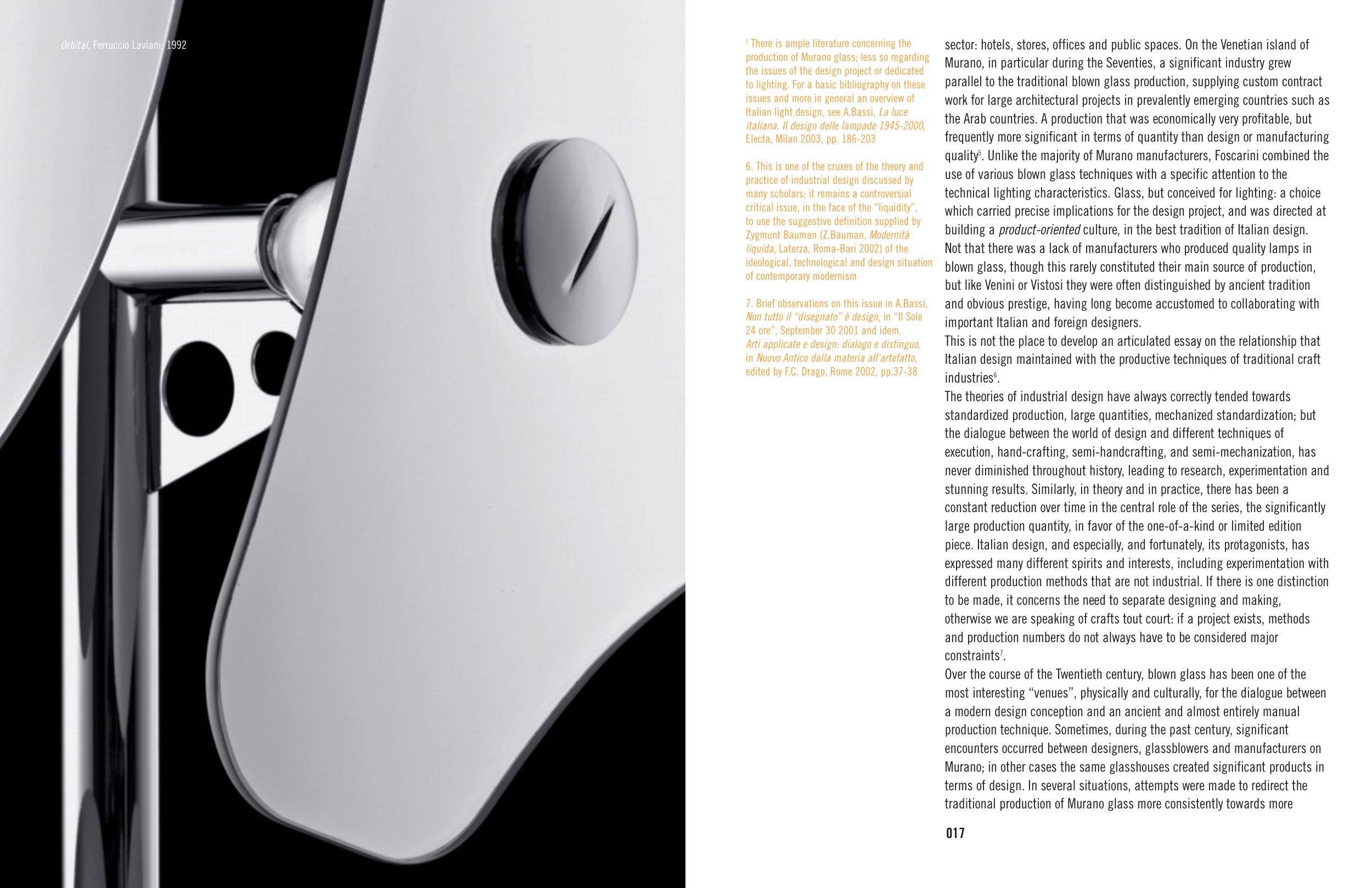017
5 There is ample literature concerning the
production of Murano glass; less so regarding
the issues of the design project or dedicated
to lighting. For a basic bibliography on these
issues and more in general an overview of
Italian light design, see A.Bassi, La luce
italiana. Il design delle lampade 1945-2000,
Electa, Milan 2003, pp. 186-203
6. This is one of the cruxes of the theory and
practice of industrial design discussed by
many scholars; it remains a controversial
critical issue, in the face of the “liquidity”,
to use the suggestive definition supplied by
Zygmunt Bauman (Z.Bauman, Modernità
liquida, Laterza, Roma-Bari 2002) of the
ideological, technological and design situation
of contemporary modernism
7. Brief observations on this issue in A.Bassi,
Non tutto il “disegnato” è design, in “Il Sole
24 ore”, September 30 2001 and idem.
Arti applicate e design: dialogo e distinguo,
in Nuovo Antico dalla materia all’artefatto,
edited by F.C. Drago, Rome 2002, pp.37-38
Orbital, Ferruccio Laviani, 1992
sector: hotels, stores, offices and public spaces. On the Venetian island of
Murano, in particular during the Seventies, a significant industry grew
parallel to the traditional blown glass production, supplying custom contract
work for large architectural projects in prevalently emerging countries such as
the Arab countries. A production that was economically very profitable, but
frequently more significant in terms of quantity than design or manufacturing
quality5. Unlike the majority of Murano manufacturers, Foscarini combined the
use of various blown glass techniques with a specific attention to the
technical lighting characteristics. Glass, but conceived for lighting: a choice
which carried precise implications for the design project, and was directed at
building a product-oriented culture, in the best tradition of Italian design.
Not that there was a lack of manufacturers who produced quality lamps in
blown glass, though this rarely constituted their main source of production,
but like Venini or Vistosi they were often distinguished by ancient tradition
and obvious prestige, having long become accustomed to collaborating with
important Italian and foreign designers.
This is not the place to develop an articulated essay on the relationship that
Italian design maintained with the productive techniques of traditional craft
industries6.
The theories of industrial design have always correctly tended towards
standardized production, large quantities, mechanized standardization; but
the dialogue between the world of design and different techniques of
execution, hand-crafting, semi-handcrafting, and semi-mechanization, has
never diminished throughout history, leading to research, experimentation and
stunning results. Similarly, in theory and in practice, there has been a
constant reduction over time in the central role of the series, the significantly
large production quantity, in favor of the one-of-a-kind or limited edition
piece. Italian design, and especially, and fortunately, its protagonists, has
expressed many different spirits and interests, including experimentation with
different production methods that are not industrial. If there is one distinction
to be made, it concerns the need to separate designing and making,
otherwise we are speaking of crafts tout court: if a project exists, methods
and production numbers do not always have to be considered major
constraints7.
Over the course of the Twentieth century, blown glass has been one of the
most interesting “venues”, physically and culturally, for the dialogue between
a modern design conception and an ancient and almost entirely manual
production technique. Sometimes, during the past century, significant
encounters occurred between designers, glassblowers and manufacturers on
Murano; in other cases the same glasshouses created significant products in
terms of design. In several situations, attempts were made to redirect the
traditional production of Murano glass more consistently towards more


